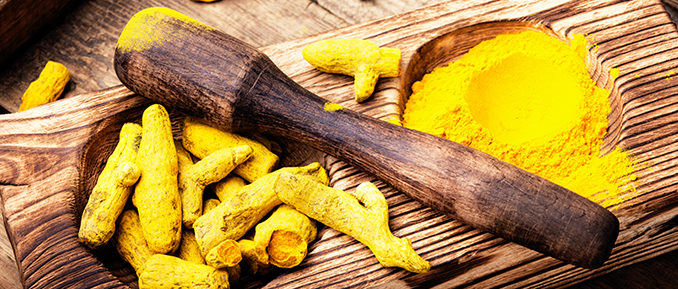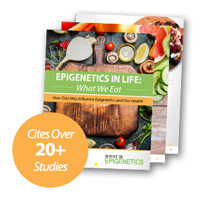
For centuries, people all around the globe have known about the health benefits of herbs and spices. One spice, in particular, stands out not only for its bright yellow color but also for its potent healing powers. This wonder spice is Curcuma longa, commonly known as turmeric, and it belongs to the ginger family.
Traditionally used in Indian cooking as a main ingredient in curry powder, this spice is also used to make medicine. Numerous studies have promoted turmeric as a powerful antioxidant and for its ability to reduce pain and swelling. It’s commonly taken to relieve arthritis, improve wound healing, boost memory and mood, even to treat cancer.
Naturally-occurring chemical compounds found in certain foods, herbs, and minerals are known to possess beneficial epigenetic effects. Scientists have found over 300 compounds in turmeric, but the one that has been given the most attention is curcumin, primarily for its anti-inflammatory properties. Now, this compound is proving to be effective in reducing liver damage caused by a widely used hyperthyroidism medication. How it works may be due to its ability to restore the epigenetic modifications induced by the drug.
Thyroid hormones are essential for the function of nearly every cell in the body. They help control numerous metabolic processes that are critical for normal growth and development, as well as regulating metabolism. Hyperthyroidism occurs when the thyroid gland produces too much of these hormones. This can cause rapid heart rate, weight loss, nervousness, difficulty sleeping, and more.
Drugs used to combat this condition have been successful in reducing the activity of the thyroid and restoring metabolic function. However, the side effects of one particular drug, 6-n-propyl-2-thiouracil (PTU), can adversely affect the liver. In a recent study published in Food and Chemical Toxicology a group of researchers investigated PTU’s epigenetic effect on the liver and whether or not curcumin could remedy its adverse effects.
Previous animal studies have shown that curcumin hinders oxidative stress caused by chemical treatment and certain disease states, including PTU-induced hypothyroidism. There’s also growing evidence that epigenetics and oxidative stress may be linked in the pathology of various human diseases. Knowing this, the researcher’s intent was to understand the epigenetic processes involved.
Epigenetics is a term that describes heritable and reversible marks that control gene expression without altering DNA sequence. DNA methylation is a common epigenetic mechanism and DNA methyltransferases (DNMTs) and methyl CpG binding domain proteins (MBDs) are two of its families of proteins. DNMT member, DNMT1, maintains DNA methylation patterns and genomic stability, whereas DNMT3a and DNMT3b are responsible for new or de novo methylation patterns. Of the MBD group, MBD4 contributes to DNA repair and MeCP2 is involved in gene repression. DNA methylation is also be influenced by stressors in the environment and two stress response proteins known to affect genomic stability, cellular response, and DNA repair are Gadd45a and p53.
By examining the proteins involved in DNA methylation, genomic stabilization, and cellular repair, the researchers hope to determine which epigenetic modifications affect liver function. The team also investigated C/EBP-β, which helps regulate many liver cell-specific genes, and PCNA, which is involved in DNA replication and cell cycle regulation. Focusing on all these areas, the researchers hoped to first determine the epigenetic impact of PTU on liver tissue and then assess the effectiveness of curcumin on the PTU-induced changes.
Their results confirmed PTU’s ability to inhibit thyroid hormone production and verified its heptotoxicity (or chemically-driven liver damage). It also demonstrated that hormone reduction and liver injury coincided with upregulation in the expression of DNMT1, DNMT3a, DNMT3b, MBD4, MeCP2, p53, and Gadd45a, as well as a down-regulation of PCNA and C/EBP-β. However, when curcumin was administration alongside PTU, these epigenetic parameters, except for MBD4, were reduced together with a decrease in oxidative stress.
According to the report, “Co-administration of curcumin with PTU resulted in restoration of hepatic cell population and histoarchitecture. The protective effect of curcumin to PTU-induced hepatotoxicity is attributed to its antioxidative properties.”
While further research is needed to determine the exact molecular mechanisms involved here. The study does provide evidence that curcumin may protect the liver from injury caused by the anti-thyroid drug. Furthermore, it highlights the considerable value that curcumin has as a potential therapeutic, especially for the treatment of PTU-induced hepatotoxicity.
Source: Suresh Kumar Bunker et al. (2018) Curcumin restores hepatic epigenetic changes in propylthiouracil(PTU)- Induced hypothyroid male rats: A study on DNMTs, MBDs, GADD45a, C/EBP-β and PCNA. Food and Chemical Toxicololgy. 123:169-180.


